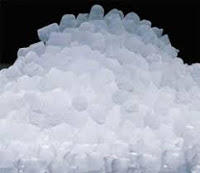There is no rule stating the container has to break when the water is frozen. All freezing water does is increase the building pressure inside the container. The higher pressure may not cause the container to break, but it does cause a different type of ice crystal to form inside.
So the answer to the question is that the water still turns into ice, but if it truly cannot break the bonds of the container, it is trapped inside under certain circumstances, it turns into a very different kind of ice than we’re often used to seeing.
Scientists currently know of 15 different solid phases of water, with all of them being called “ice.” Each type of solid phase or ice is distinct due to the different density and internal structure of molecules found in the water. The form of ice you’re likely most familiar with is Hexagonal Ice, which is what forms when water normally freezes under regular conditions without constrictions. If one keeps lowering the temperature of Hexagonal ice in the freezer, it eventually becomes Cubic Ice, and when you tweak the temperature and pressure further, you will be able to create more kinds, like Ice II, Ice III, all the way up to Ice XV.
Why does water expand when it is turned to ice?
Almost all liquids contract whenever they are freeze. The molecules found on liquids are often scattered, although they are not so far away from each other that they may look like gasses. Whenever these molecules are frozen, they would often move closer to each other until they form a structure similar to those found in solids, wherein its molecules look very tightly knit that there are no open spaces on them. Because the molecules of the liquid consume less space in its container since they stick closer together, the size of the liquid gets smaller. As the temperature lowers in the container, the molecules will bond even more tightly until they form a solid structure.
While most liquids would contract whenever they are frozen, water does the opposite when it gets to a certain temperature. Water would still contract if it is frozen at 4 degrees Celsius; however, when it gets past 4 degrees, it would expand by about 9%.
The reason why water expands when turned into ice is because of its unique structure that is not found in other forms of liquid. As many of us known, water is H2O (dihydrogen monoxide), which means it has two hydrogen molecules connected to one oxygen molecule, and this bond between the two molecules usually grows stronger when they are frozen.
The hydrogen molecules are the ones that bond closer whenever its structure is turned to ice, while the oxygen molecules tend to stay away from each other. The oxygen molecules cause an expansion in the structure since they wouldn’t bond, and they subsequently create open spaces in the ice. Ice would often form in a six-sided crystalline structure, and in between the connections are the oxygen molecules that form the open spaces of the ice. If the ice is turned into water by increasing the temperature in the container, then the water molecules will become separated again, although at a much slower pace compared to when it forms into ice.
Some would say that ice is transparent, but it is actually translucent. The connections on the molecules of the ice are strong enough to not let light pass through it easily, although its open spaces formed by its crystalline structure allow some light to go through it, which is why it is still see-through.
Interestingly, research suggests that water is denser than ice, which is the reason why ice would often float on top of the water. The density of water is also why frozen lakes or ponds only have ice at the top since the temperature cannot penetrate the structure of the liquid that is in the deeper portions of the said bodies of water because the density there is higher than the portion at the top. If water behaves like most liquids, then there is a chance that the whole pond or lake will be frozen, and those animals living there would eventually perish.

